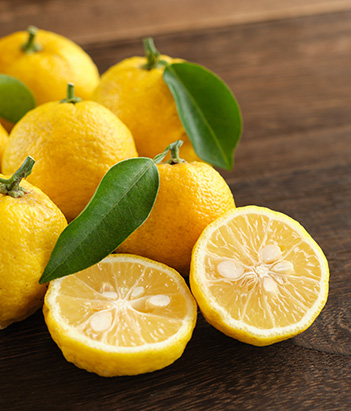
Yuzu Fragrance
Yuzu’s seductively complex scent harmonizes with its flavor. Notes of mandarin mingle with lemon, lime, and grapefruit, while bergamot hovers in the distance, like a memory—a hesperidean quintet (see: Grapefruit and Bigarade Orange). Green, herbaceous, and resinous notes enhance yuzu’s freshness, punctuated by floral accents. Yuzu also has a discreet woody side, with streaks of fresh hops, coconut, and thyme.
Description
A japanese citrus
Born in China and Tibet by crossing wild mandarin and lemon trees, yuzu (Citrus x junos) is sourness made elegant. In Japan, the best yuzu fruit is found on Shikoku, the smallest of the archipelago’s four main islands, a citrus-growing paradise where the mikan (satsuma) and an extraordinary green citrus fruit, the sudachi, also grow. With its pebbled, bumpy skin, stuffed with seeds, yuzu may not be much to look at, and the amount of juice each fruit yields is small, but the enchanting, heady scent and flavor of zest and juice more than compensate.
A popular ingredient in cooking and in perfumery !
Yuzu’s rising popularity in fragrance has tracked the growing influence of ginger—both are energy incarnate. The fashion for yuzu is explained in part by its recent cultivation outside Asia. In Europe, the fruit really took off in cuisine after 2002, when the Catalan chef Ferran Adrià discovered it during a trip to Japan. In Calvados, some farmers grow yuzu and saffron together: a truly noble harvest.
Yuzu’s exuberant top notes make it a natural asset in eaux fraîches and eaux de colognes. Recently, Acqua di Parma’s Yuzu, Signature of the Sun (2019) has played the citrus card: a yuzu-bergamot accord dusted with mimosa over base notes of sandalwood and musk.
Take inspiration from the cedarwood fruit presses of Shikoku and layer Candora’s Yuzu over Cedar. Reinforce Yuzu’s discreet floral notes with Rose. Or highlight the warmth of Sandalwood with Yuzu’s sunny sparkle.
